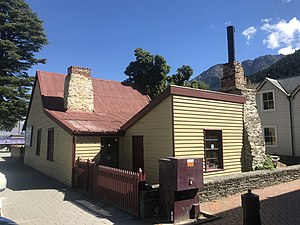- Williams Cottage, the oldest house in Queenstown, in 2021
- Arrowtown Masonic Lodge in 2021
- Hulbert House in Queenstown
Related Research Articles
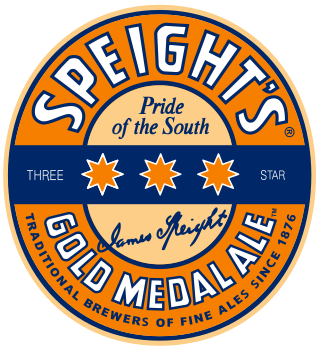
Speight's is a brewery located in Dunedin, New Zealand. The brewery is owned by the Japanese-controlled holding company Lion. It is best known for its Gold Medal Ale, one of the best-selling beers in New Zealand. The brewery also gave rise to a chain of Speight's Ale House gastropubs across the country.

Queenstown is a resort town in Otago in the south-west of New Zealand's South Island. It has an urban population of 15,800.

Arrowtown is a historic gold mining town in the Otago region of the South Island of New Zealand. Arrowtown is located on the banks of the Arrow River approximately 7.5 km from State Highway 6. Arrowtown is located 19.5 kilometres to the east of Queenstown. As well as the route via State Highway 6 at Arrow Junction, there is also road access directly to Queenstown via Arthurs Point and a third route via the picturesque Lake Hayes.

The Otago Gold Rush was a gold rush that occurred during the 1860s in Central Otago, New Zealand. This was the country's biggest gold strike, and led to a rapid influx of foreign miners to the area – many of them veterans of other hunts for the precious metal in California and Victoria, Australia.

Princes Street is a major street in Dunedin, the second largest city in the South Island of New Zealand. It runs south-southwest for two kilometres from The Octagon in the city centre to the Oval sports ground, close to the city's Southern Cemetery. North of The Octagon, George Street continues the line of Princes Street north-northeast for two and a half kilometres. Princes Street is straight but undulating, skirting the edge of the City Rise to its northwest. The part of the street immediately below The Octagon is the steepest section, as the road traverses an old cutting through Bell Hill.
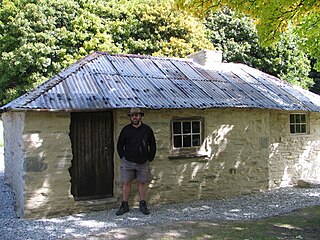
Macetown is an historic gold mining settlement in the Otago region of the South Island of New Zealand. It is now uninhabited but has become a tourist attraction. Access to the town is via an unsealed road that heads up the steep-sided Arrow gorge. This can be traversed on foot or by mountain bike, horse or four-wheel-drive vehicles. The road crosses the Arrow River or its side creeks 22 times and is not suitable for two-wheel-drive cars. The start of the road is found in the Arrowtown car park.

Robert Arthur Lawson was one of New Zealand's pre-eminent 19th century architects. It has been said he did more than any other designer to shape the face of the Victorian era architecture of the city of Dunedin. He is the architect of over forty churches, including Dunedin's First Church for which he is best remembered, but also other buildings, such as Larnach Castle, a country house, with which he is also associated.
Architecture of New Zealand is the built environment of regions, cities and towns of New Zealand.
Cobb & Co is the name of a company that operated a fleet of stagecoaches in Australia in the late 19th century. Cobb & Co themselves did not operate in New Zealand officially but its name was used by many private stage coach operators.
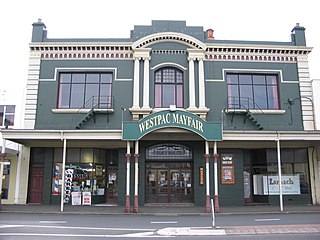
The Mayfair Theatre, Dunedin, New Zealand, was opened on 8 December 1914 as the "King Edward Picture Theatre". It is owned by the Mayfair Theatre Charitable Trust and serves as a 400-seat venue for live performances for a number of local community groups and as the Dunedin venue for some touring agencies.

The Dunedin Town Hall, also known as the Dunedin Centre, is a municipal building in the city of Dunedin in New Zealand. It is located in the heart of the city extending from The Octagon, the central plaza, to Moray Place through a whole city block. It is the seat of the Dunedin City Council, providing its formal meeting chamber, as well as a large auditorium and a conference centre. The oldest part of the building has been called the only substantial Victorian town hall still in existence in New Zealand.

Robert Gillies was a 19th-century Member of Parliament in Otago, New Zealand. He was born in Rothesay on the Isle of Bute, Scotland.
Queenstown Police Station is the largest police station in the Otago Lakes Central Area which is one of three policing areas in the Southern District of the New Zealand Police. The Otago Lakes Central Area headquarters has returned to Queenstown Police Station after a period at Alexandra Police Station. The area of responsibility covered by the Queenstown Police extends from Kingston in the south, to the Crown Range summit in the north, and from Glenorchy and its environs in the west, to the Roaring Meg power station in the Kawarau Gorge in the east.

Mason & Wales is New Zealand's oldest surviving architectural design company. They were the architects on Dunedin buildings the Wains Hotel (1878), Garrison Hall (1879), the Scott Building (1916) at the University of Otago Dunedin School of Medicine (1916) in Queenstown the Queenstown Police Station (1996).
Harriet Ann Heron was an early settler and business owner in Central Otago, New Zealand, and one of the few women who lived in gold mining camps during the Otago gold rush.

Laurence Jeremy Elder Salmond was a New Zealand conservation architect. He received the NZIA Gold Medal, the highest honour in New Zealand architecture, in 2018.
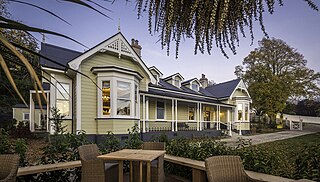
Hulbert House is a 19th-century Victorian villa on Ballarat St. in Queenstown, New Zealand, overlooking Lake Wakatipu. The house has six suites, each named after notable individuals.

This list of works by Robert Lawson categorises and provides brief details of the structures designed by Scottish-born architect Robert A. Lawson (1833–1902) who is said did more than any other designer to shape the face of the Victorian era architecture of the city of Dunedin.

The Sargood Centre is the common name for the former Exhibition Art Gallery, located at 40 Logan Park Drive in Dunedin, Otago. It is registered as a Category I heritage building by Heritage New Zealand. The building was designed by Edmund Anscombe as the art gallery for the 1925 New Zealand and South Seas International Exhibition. The building is considered of "outstanding historical significance" as it is the only exhibition building from any of New Zealand's exhibitions that is still intact and in situ, and one of only eight worldwide.
Louise Wright is a New Zealand Māori architect. She is of Te Arawa, Ngāti Tūwharetoa, Te Aitanga-a-Māhaki, Te Aitanga-a-Hauiti and Rongowhakaata descent.
References
- 1 2 3 4 5 Elizabeth Cox, ed. (2022). Making Space: A History of New Zealand Women in Architecture. Auckland: Massey University Press. ISBN 978-1-99-101634-8. OCLC 1347021085. OL 39960346M. Wikidata Q117788223.
- ↑ Houlahan, Mike (16 August 2012). "Historic brewery gets upgrade". Stuff. Retrieved 19 May 2023.
- ↑ Morris, Chris (12 September 2012). "Questions over consent for Speight's". Otago Daily Times Online News. Retrieved 19 May 2023.
- ↑ "Mrs Heron's Cottage | Jackie Gillies + Associates | Conservation + Creative Reuse of Historic Buildings". www.jackiegillies.co.nz. Archived from the original on 13 January 2015. Retrieved 23 June 2016.
- ↑ Miller, Robin (2011). "Pieces of the jigsaw - the early development of concrete in Otago, New Zealand". Proceedings of the 16th Engineering Heritage Australia Conference, Hobart, November 2011: 1–22.
- ↑ Dungey, Kim (4 December 2010). "'Fantastic compromise' saves day". Otago Daily Times Online News. Retrieved 19 May 2023.
- ↑ "Origin Consultants". www.originteam.co.nz. Retrieved 19 May 2023.
